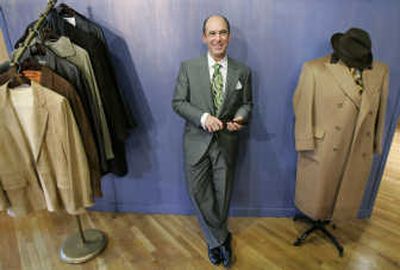Belt-tightening by rich squeezes others

NEW YORK – It’s hard to feel sorry for well-heeled shoppers whose idea of tough economic times is passing on $1,000 Burberry raincoats or that $300 limo ride while the working poor skimp on vegetables and take the bus.
But economists say that recent signs of cutting back by the affluent could hurt the economy and deliver even more pain to lower-income workers, who are dependent on their business and fat tips.
Nathan Warren, a limo driver, knows this firsthand: He has seen his monthly wages drop by 40 percent to about $1,800 since late last year. His workweek at Newport Beach, Calif.-based Classy Ride Limousine Service was reduced to three days from five amid slow business.
“I have to struggle to get by. I am pinching pennies,” said Warren, 30, a Costa Mesa, Calif., resident. “I am eating more cereal and am not buying clothing.”
Cutbacks by the wealthy have a ripple effect across all consumer spending, said Michael P. Niemira, chief economist at the International Council of Shopping Centers. That’s because American households in the top 20 percent by income — those making at least $150,000 a year — account for about 40 percent of overall consumer spending, which makes up two-thirds of economic activity.
Niemira expects the retail sector, whose growth was fueled in part by strong gains at luxury chains, will struggle to eke out a 1 percentage sales increase in stores opened at least a year during the next few months. That’s below the 2.1 percent average for 2007 and 3.7 percent for 2006.
Just look at the cutbacks by Dali Wiederhoft, a 52-year-old marketing executive from Reno, Nev., made skittish by a volatile stock market, a 20 percent decline in her home value and recession fears.
Over the past three months Wiederhoft pared her spending on clothes to $500 per month from about $3,000; that means no more Jimmy Choo shoes and David Yurman jewelry. Her cutbacks also included canceling the services of a cleaning woman and a lawn care company. She also plans to trade in her BMW for a Ford when her lease expires in about a month.
“This is a time to have cash, not to spend. So, I’m cutting wherever I can,” she said.
Such reined-in spending seems to be the end of a winning streak for luxury retailers that once appeared immune to the economic slowdown. Tiffany & Co. and Williams-Sonoma Inc. both reduced their earnings outlooks and Burberry PLC said it may miss its 2008 profit forecast. Coach Inc. reported a 1.1 percent decline in same-store sales at its North American stores for the second quarter ended Dec. 29, 2007. And Compagnie FinanciGere Richemont SA, the Swiss parent of Cartier and Baume & Mercier, reported a slowdown in holiday sales growth.
Soaring home values had made upper-middle class shoppers feel wealthy in recent years, causing them to trade up to $500 Coach handbags and $1,000 espresso makers, but a housing slump has wiped away their paper wealth. The woes are creeping into even the high-end luxury sector, as affluent shoppers are rattled by the turbulence in the financial markets.
American Express Co., whose customers are generally affluent, said it expects slower spending and more missed payments on credit cards throughout 2008.
The economy needs affluent shoppers to spend with enthusiasm. According to the government’s latest survey of consumer expenditures, the top 20 percent of households spend about $94,000 annually, almost five times the bottom 20 percent and more per year than the bottom sixty percent combined.
Then there’s also the multiplier effect. When shoppers splurge on $1,000 dinners and $300 limousine rides, that means fatter tips for the waiter and the driver. Sales clerks at upscale stores, who typically earn sales commissions, also depend on spending sprees of mink coats and jewelry. But the trickling down is starting to dry up, threatening to hurt a broad base of low-paid workers.
Overall, the super wealthy — consumers with a net worth of more than $10 million — are still splurging on $1 million boats, $10 million diamond jewelry and other luxuries, according to Milton Pedraza, chief executive of the Luxury Institute, a research institute based in New York.
But this crowd could stop splurging, simply because they’re not in the mood. That happened right after the Sept. 11, 2001, terrorist attacks, though luxury spending rebounded soon after.
Luxury stores, which have a big presence in New York, are closely monitoring Wall Street. The financial industry accounts for about 20 percent of wages in New York City, according to the state comptroller’s office.
Alan Johnson, managing director of Johnson Associates, a leading executive compensation consultancy, expects bonuses to fall as much as 30 percent this year. But more importantly, massive layoffs on Wall Street could cause the affluent to pull back even more.